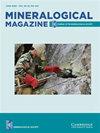Alumolukrahnite, CaCu2+Al(AsO4)2(OH)(H2O), the aluminium analogue of lukrahnite from the Jote mine, Copiapó Province, Chile
IF 1.4
3区 地球科学
Q2 MINERALOGY
引用次数: 1
Abstract
Abstract The new mineral alumolukrahnite (IMA2022–059), CaCu2+Al(AsO4)2(OH)(H2O), was found at the Jote mine, Copiapó Province, Chile, where it is a secondary alteration phase associated with conichalcite, coronadite, gypsum, olivenite, pharmacosiderite, rruffite and scorodite. Alumolukrahnite occurs as crude diamond-shaped tablets up to ~0.1 mm, intergrown in crude spherical aggregates. Crystals are apple green and transparent to translucent, with vitreous lustre and a white streak. The Mohs hardness is 3½. The mineral is brittle with irregular fracture and no cleavage. The calculated density is 4.094 g cm–3. Optically, alumolukrahnite is biaxial (+) with α = 1.73(1), β = 1.74(1) and γ = 1.76(1) (white light). The empirical formula, determined from electron microprobe analyses, is Ca1.01(Cu0.92Zn0.13)Σ1.05(Al0.96Fe0.01)Σ0.97(As0.985O4)2(OH)0.88(H2O)1.12. Alumolukrahnite is triclinic, P$\bar{1}$, a = 5.343(5), b = 5.501(5), c = 7.329(5) Å, α = 67.72(2), β = 69.06(2), γ = 69.42(2)°, V = 180.3(3) Å3 and Z = 1. Alumolukrahnite is a member of the tsumcorite group and is the Al analogue of lukrahnite.alololuhnite, cucu2 +Al(AsO4)2(OH)(H2O), alololuhnite的类似物,产自智利Copiapó省Jote矿
摘要:在智利Copiapó省Jote矿中发现了一种新矿物铝榴辉石(IMA2022-059), CaCu2+Al(AsO4)2(OH)(H2O),该矿物为次级蚀变相,与锥辉石、冠状石、石膏、橄榄石、药黄石、铁榴石和铁榴石伴生。铝榴辉石以粗菱形片剂的形式出现,片剂可达~0.1 mm,在粗球形集合体中交错生长。晶体为苹果绿色,透明至半透明,具有玻璃光泽和白色条纹。莫氏硬度是3½。该矿物易碎,呈不规则断裂,无解理。计算密度为4.094 g cm-3。光学上,铝榴辉石为双轴(+),α = 1.73(1), β = 1.74(1), γ = 1.76(1)(白光)。由电子探针分析得到的经验公式为Ca1.01(Cu0.92Zn0.13)Σ1.05(Al0.96Fe0.01)Σ0.97(As0.985O4)2(OH)0.88(H2O)1.12。Alumolukrahnite三斜,P{1} \酒吧,美元= 5.343 (5),b = 5.501 (5), c = 7.329(5),α= 67.72(2),β= 69.06(2),γ= 69.42(2)°,V = 180.3 (3) A3和Z = 1。铝榴辉石是闪长岩群的一员,是铝榴辉石的类似物。
本文章由计算机程序翻译,如有差异,请以英文原文为准。
求助全文
约1分钟内获得全文
求助全文
来源期刊

Mineralogical Magazine
地学-矿物学
CiteScore
4.00
自引率
25.90%
发文量
104
审稿时长
6-12 weeks
期刊介绍:
Mineralogical Magazine is an international journal of mineral sciences which covers the fields of mineralogy, crystallography, geochemistry, petrology, environmental geology and economic geology. The journal has been published continuously since the founding of the Mineralogical Society of Great Britain and Ireland in 1876 and is a leading journal in its field.
 求助内容:
求助内容: 应助结果提醒方式:
应助结果提醒方式:


